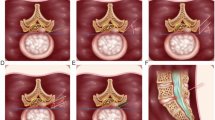Abstract
The objective of the study was to demonstrate the clinical characteristics of dural tears during percutaneous endoscopic lumbar discectomy (PELD) and to discuss how to prevent this unintended complication. The study used data from 816 consecutive patients who underwent PELD between 2003 and 2007. A total of nine patients (1.1%) experienced symptomatic dural tears. The clinical outcomes were evaluated using the visual analogue scale (VAS), the Oswestry disability index (ODI), and modified MacNab criteria. Intractable radicular pain was the most common symptom, while classical manifestations, such as CSF leakage or wound swelling, were rare. In three of the nine cases, the dural tears were detected intraoperatively, while the remaining six cases were not recognized during the procedure. Among the unrecognized patients, two patients were found with nerve root herniation causing profound neurological deficits. All patients were managed by secondary open repair surgeries. The mean follow-up period was 30.8 months. The mean VAS of radicular leg pain improved from 8.3 to 2.6, and that of back pain improved from 4.1 to 2.6. The mean ODI improved from 69.6 to 29.2%. The final outcomes were excellent in one, good in five, fair in one, and poor in two patients. As application of the endoscopic procedure has been broadened to more complex cases, the risk of dural tears may increase. Unrecognized dural tear with nerve root herniation may cause permanent neurological sequelae. Accurate information and proper technical considerations are essential to prevent this unpredictable complication.



Similar content being viewed by others
References
Ahn Y, Lee SH, Park WM, Lee HY, Shin SW, Kang HY (2004) Percutaneous endoscopic lumbar discectomy for recurrent disc herniation: surgical technique, outcome, and prognostic factors of 43 consecutive cases. Spine 29:E326
Bosacco SJ, Gardner MJ, Guille JT (2001) Evaluation and treatment of dural tears in lumbar spine surgery: a review. Clin Orthop Relat Res 389:238–247
Cammisa FP Jr, Girardi FP, Sangani PK, Parvataneni HK, Cadag S, Sandhu HS (2000) Incidental durotomy in spine surgery. Spine 25:2663–2667
Goodkin R, Laska LL (1995) Unintended “incidental” durotomy during surgery of the lumbar spine: medicolegal implications. Surg Neurol 43:4–12
Hasegawa K, Yamamoto N (1999) Nerve root herniation secondary to lumbar puncture in the patient with lumbar canal stenosis. A case report. Spine 24:915–917
Hermantin FU, Peters T, Quartararo L, Kambin P (1999) A prospective, randomized study comparing the results of open discectomy with those of video-assisted arthroscopic microdiscectomy. J Bone Joint Surg Am 81:958–965
Hodges SD, Humphreys SC, Eck JC, Covington LA (1999) Management of incidental durotomy without mandatory bed rest. A retrospective review of 20 cases. Spine 24:2062–2064
Jones AA, Stambough JL, Balderston RA, Rothman RH, Booth RE Jr (1989) Long-term results of lumbar spine surgery complicated by unintended incidental durotomy. Spine 14:443–446
Kambin P, Brager MD (1987) Percutaneous posterolateral discectomy. Anatomy and mechanism. Clin Orthop Relat Res 223:145–154
Khan MH, Rihn J, Steele G, Davis R, Donaldson WF 3rd, Kang JD, Lee JY (2006) Postoperative management protocol for incidental dural tears during degenerative lumbar spine surgery: a review of 3,183 consecutive degenerative lumbar cases. Spine 31:2609–2613
Knight M, Goswami A (2003) Management of isthmic spondylolisthesis with posterolateral endoscopic foraminal decompression. Spine 28:573–581
Maroon JC (2002) Current concepts in minimally invasive discectomy. Neurosurgery 51:S137–S145
Nishi S, Hashimoto N, Takagi Y, Tsukahara T (1995) Herniation and entrapment of a nerve root secondary to an unrepaired small dural laceration at lumbar hemilaminectomies. Spine 20:2576–2579
Saxler G, Krämer J, Barden B, Kurt A, Pförtner J, Bernsmann K (2005) The long-term clinical sequelae of incidental durotomy in lumbar disc surgery. Spine 30:2298–2302
Sin AH, Caldito G, Smith D, Rashidi M, Willis B, Nanda A (2006) Predictive factors for dural tear and cerebrospinal fluid leakage in patients undergoing lumbar surgery. J Neurosurg Spine 5:224–227
Stolke D, Sollmann WP, Seifert V (1989) Intra- and postoperative complications in lumbar disc surgery. Spine 14:56–59
Tafazal SI, Sell PJ (2005) Incidental durotomy in lumbar spine surgery: incidence and management. Eur Spine J 14:287–290
Töppich HG, Feldmann H, Sandvoss G, Meyer F (1994) Intervertebral space nerve root entrapment after lumbar disc surgery. two cases. Spine 19:249–250
Wang JC, Bohlman HH, Riew KD (1998) Dural tears secondary to operations on the lumbar spine. Management and results after a two-year-minimum follow-up of eighty-eight patients. J Bone Joint Surg Am 80:1728–1732
Yeung AT, Tsou PM (2002) Posterolateral endoscopic excision for lumbar disc herniation: surgical technique, outcome, and complications in 307 consecutive cases. Spine 27:722–731
Author information
Authors and Affiliations
Corresponding author
Rights and permissions
About this article
Cite this article
Ahn, Y., Lee, H.Y., Lee, SH. et al. Dural tears in percutaneous endoscopic lumbar discectomy. Eur Spine J 20, 58–64 (2011). https://doi.org/10.1007/s00586-010-1493-8
Received:
Revised:
Accepted:
Published:
Issue Date:
DOI: https://doi.org/10.1007/s00586-010-1493-8




